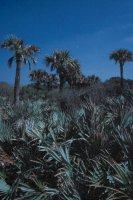 The coastal strand is a thin strip of fragile, woody vegetation that lies between the beach and the maritime hammock. This community is found only along the east coast of Florida and provides a dense growth of native plants such as palmetto, sand live oak and Spanish palms. This dense vegetation is the perfect place for the southeastern beach mouse, gopher tortoise, indigo snake and other rare and endangered species.
The coastal strand is a thin strip of fragile, woody vegetation that lies between the beach and the maritime hammock. This community is found only along the east coast of Florida and provides a dense growth of native plants such as palmetto, sand live oak and Spanish palms. This dense vegetation is the perfect place for the southeastern beach mouse, gopher tortoise, indigo snake and other rare and endangered species.
Coastal strand habitat once formed a continuous band up and down the coast, but it is now vanishing quickly due to coastal development. In addition, introduced species (such as house cats) are wiping out beach mice and coastal birds. The coastal strand is now severely fragmented, leading to the loss of several local beach mouse populations.
The maritime hammock community is found just inland from the coastal strand. This community becomes established on older dunes that are stable enough to support the growth of trees. Plant species include live oak, cabbage palms, wild coffee, coral bean and several species of ferns.
 The maritime hammock provides habitat for many species of animals including tree frogs, squirrels, scrub jays, blue-tailed skinks and both resident and migratory song birds. Unfortunately, these areas are well-suited for development because of the stable, well-drained soil, leading to the rapid decline of maritime hammock habitat.
The maritime hammock provides habitat for many species of animals including tree frogs, squirrels, scrub jays, blue-tailed skinks and both resident and migratory song birds. Unfortunately, these areas are well-suited for development because of the stable, well-drained soil, leading to the rapid decline of maritime hammock habitat.
Besides their ecological importance, many maritime hammocks contain shell mounds, or middens, left by Florida’s original human inhabitants and provide an important archeological link to Florida’s history.
 Barrier islands are naturally formed by shifting sands that build upon an existing sandbar to eventually form an island. The sand that has accumulated above the water surface becomes the home for the drifting seeds of beach plants. As the seeds grow and develop, their roots stabilize the soil, allowing the development of coastal strand and maritime hammock communities.
Barrier islands are naturally formed by shifting sands that build upon an existing sandbar to eventually form an island. The sand that has accumulated above the water surface becomes the home for the drifting seeds of beach plants. As the seeds grow and develop, their roots stabilize the soil, allowing the development of coastal strand and maritime hammock communities.
Barrier islands support a variety of plant and animal species that are either rare, threatened or endangered.
Barrier islands are greatly affected by the forces of wind and waves and are constantly moving towards or away from the mainland. Because barrier islands provide mainland protection from hurricanes and large storms by absorbing the impact of waves and storm water over flow, entire barrier islands can be severely reshaped or completely destroyed by a major storm.